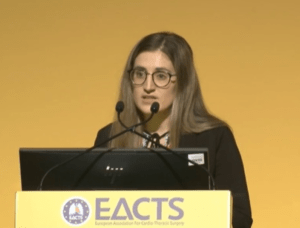Nonagenarians should not be refused transcatheter aortic valve implantation (TAVI) based solely upon their age, the findings of an analysis presented at the European Society of Cardio-Thoracic Surgery annual meeting (EACTS 2021; 13–16 October; Barcelona, Spain and virtual) suggest. This was the conclusion of Roxanne St-Louis (Quebec Heart and Lung University Institute, Quebec, Canada) who detailed a retrospective review of the survival benefit among nonagenarians undergoing TAVI.
The global population is aging, with the average age expected to be four times higher in 2041 than in 2006 in Canada, St-Louis told EACTS attendees, adding that nonagenarians may often be refused TAVI due to concerns about frailty and survival. According to American Heart Association and American Stroke Association (AHA/ASA) guidelines, in octogenarians, TAVI is a class I recommendation, with surgical aortic valve replacement (SAVR) remaining a class IIa recommendation.
St-Louis and colleagues conducted a retrospective study in patients >90 years old, who had been referred for TAVI over 12 years (2008‒2020) to the Quebec Heart and Lung University Institute, Quebec, Canada. A total of 255 patients were recruited, consisting of 171 TAVI patients and 84 who received alternative medical treatment. Among the patients with the alternative medical treatment (n=84), one-third refused surgery while two-thirds were refused by the heart team. All patients were split into two groups between TAVI and medical treatment and matched 1:1 for age and gender. The TAVI patients were compared to the general Quebec population within an extracted survival curve for age, gender, and year.

The study results illustrated differences in baseline characteristics between TAVI and medical treatment groups. Dyslipidemia was 71% in TAVI patients compared to 57% in medical treatment patients (p=0.031). Systolic pulmonary artery pressure (sPAP) in TAVI and medical treatment patients were 48 (±15) mmHg and 42 (±16) mmHg (p=0.001) respectively. Transfemoral TAVI was seen in 72% of TAVI patients, with 28% receiving alternative access. Additionally, 75% of TAVI patients received a balloon-expandable valve with 25% receiving a self-expandable valve.
Furthermore, St-Louis and team performed cox regression analysis regarding factors associated with mortality in TAVI versus medical treatment patients. Associated factor hazard ratios (HR) were age increments of two years (1.29), diabetes (1.75), and arterial hypertension (1.61). All these factors were the same between the matched and unmatched cohorts. Survival was better at five-year follow-up in TAVI patients (49±8%) compared to the medical treatment group (23±6%), using the Kaplan Meier survival curve. These findings were statistically significant. Compared to the general population, St-Louis expressed that TAVI benefit is illustrated in patients nine-months post-procedure until seven years post-procedure.
The findings demonstrated TAVI improves survival compared to medical treatment, with survival reaching that of the general Quebec population. Therefore, nonagenarians should not be denied TAVI treatment solely based on age, she concluded. However, it is important to consider this is dependent on a case-to-case basis, with patients in fitter health deemed more eligible, St-Louis added.













